Venezuelan Migrants and Refugees in Latin America and the Caribbean: A Regional Profile

According to the Regional Coordination Platform for the Response for Venezuelans (R4V), as of June 2020, more than 5 million refugees and migrants from the Bolivarian Republic of Venezuela had left their country due to the ongoing political and economic crises there, with more than 4 million of them migrating to other Latin American and Caribbean countries. The COVID-19 pandemic that hit the region in early 2020 has added a new layer of complexity. Receiving countries now face the challenge of managing a public-health crisis while also addressing the needs of displaced Venezuelans and the communities in which they live.
This fact sheet presents a profile of refugees and migrants travelling across 11 Latin American and Caribbean countries in 2019—Argentina, Brazil, Chile, Colombia, Costa Rica, Ecuador, Guyana, Paraguay, Peru, Trinidad and Tobago, and Uruguay. The data analyzed come from the Displacement Tracking Matrix (DTM), through which the International Organization for Migration (IOM) collects information about refugee and migrant demographic characteristics, labor market participation, trip details, difficulties encountered while travelling, and more.
This analysis sheds light on variations in the profile of migrants and refugees arriving in each country; the living conditions they experience upon arrival; and their intentions to remain, move onward to another country, or return to Venezuela. As Latin American and Caribbean countries race to contain the public-health crisis, DTM data also offer important insights into where migrants and refugees turn for health care, and how readily they have been able to access it.